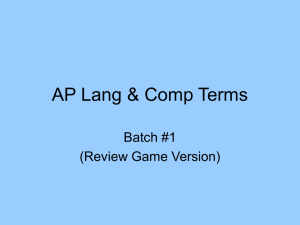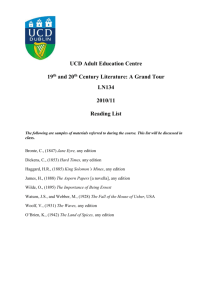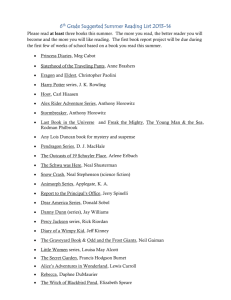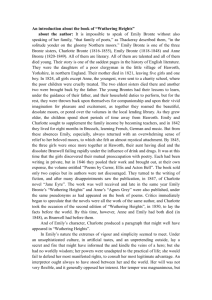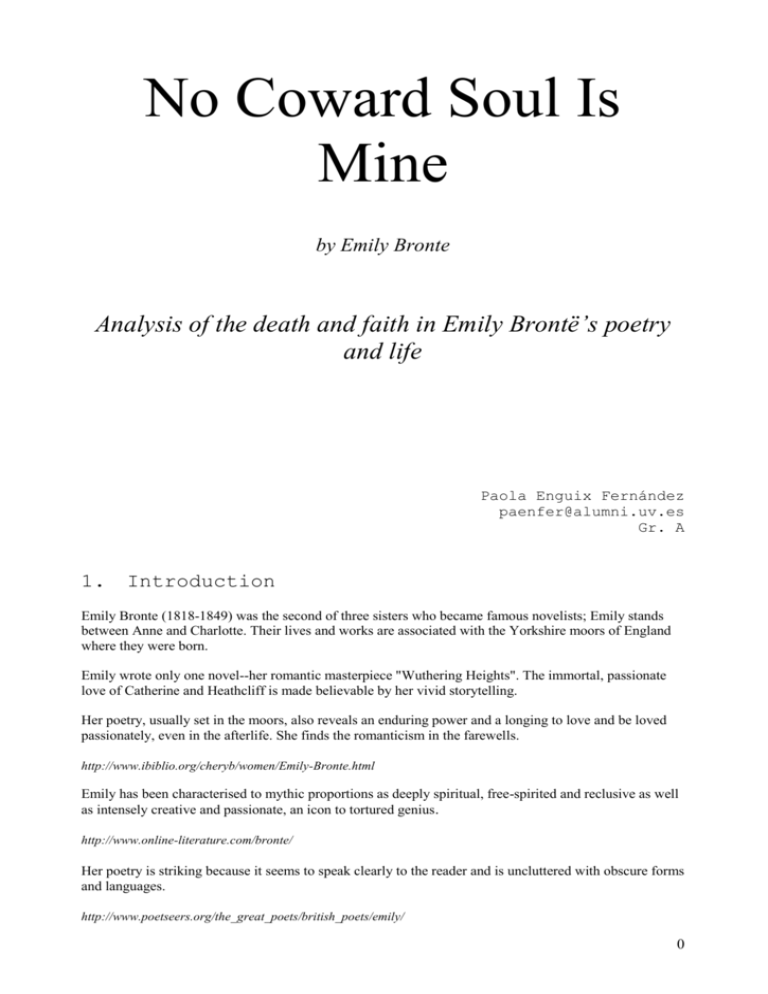
No Coward Soul Is
Mine
by Emily Bronte
Analysis of the death and faith in Emily Brontë’s poetry
and life
Paola Enguix Fernández
paenfer@alumni.uv.es
Gr. A
1.
Introduction
Emily Bronte (1818-1849) was the second of three sisters who became famous novelists; Emily stands
between Anne and Charlotte. Their lives and works are associated with the Yorkshire moors of England
where they were born.
Emily wrote only one novel--her romantic masterpiece "Wuthering Heights". The immortal, passionate
love of Catherine and Heathcliff is made believable by her vivid storytelling.
Her poetry, usually set in the moors, also reveals an enduring power and a longing to love and be loved
passionately, even in the afterlife. She finds the romanticism in the farewells.
http://www.ibiblio.org/cheryb/women/Emily-Bronte.html
Emily has been characterised to mythic proportions as deeply spiritual, free-spirited and reclusive as well
as intensely creative and passionate, an icon to tortured genius.
http://www.online-literature.com/bronte/
Her poetry is striking because it seems to speak clearly to the reader and is uncluttered with obscure forms
and languages.
http://www.poetseers.org/the_great_poets/british_poets/emily/
0
2.
The Poem:
No Coward Soul Is Mine
No coward soul is mine,
No trembler in the worlds storm-troubled sphere:
I see Heavens glories shine,
And faith shines equal, arming me from fear.
O God within my breast.
Almighty, ever-present Deity!
Life -- that in me has rest,
As I -- Undying Life -- have power in Thee!
Vain are the thousand creeds
That move mens hearts: unutterably vain;
Worthless as withered weeds,
Or idlest froth amid the boundless main,
To waken doubt in one
Holding so fast by Thine infinity;
So surely anchored on
The steadfast Rock of immortality.
With wide-embracing love
Thy Spirit animates eternal years,
Pervades and broods above,
Changes, sustains, dissolves, creates, and rears.
Though earth and man were gone,
And suns and universes ceased to be,
And Thou wert left alone,
Every existence would exist in Thee.
There is not room for Death,
Nor atom that his might could render void:
Thou -- Thou art Being and Breath,
And what Thou art may never be destroyed.
-Emily Bronte
http://www.poetseers.org/the_great_poets/british_poets/emily_bronte_poems/coward
3. Analysis of the poem
3.1. Title
The very first line of the poem, “No coward soul is mine”- also the name of the poem, shows the
closeness of the poem, and conveys a feeling of reflection and need of expression. Bronte needs to tell the
world that she is no coward, and does so in a way suited to her- verse.
http://www.eliteskills.com/c/8593
3.2. Themes
“No Coward Soul Is Mine” is a poem about Emily Bronte’s feelings for god. It tells Bronte’s views on
God, through a series of descriptions of the being himself, and how other things relate back to him, things
1
like death and faith.
Bronte’s purpose in this poem is to express her thoughts on God, as is shown in her use of first person,
and issues relating to her, like Death.
http://www.eliteskills.com/c/8593
3.3. Structure
3.3.1. First Stanza
No coward soul is mine,
No trembler in the worlds storm-troubled sphere:
I see Heavens glories shine,
And faith shines equal, arming me from fear.
In the first stanza the speaker sees "Heaven’s glories shine and Faith shines equal arming me from Fear."
This line could be read to mean that the speaker was told of the promises of an after-life and when
combined with the faith she possesses, which is as strong as the promised "Heaven’s glories," both will
give her the power to overcome any fear. Faith is the belief in something that cannot be seen, but in which
one has complete trust. "Faith" is there to give courage to anyone who must face the idea of death or the
end of life as they perceive it.
3.3.2. Second Stanza
O God within my breast.
Almighty, ever-present Deity!
Life -- that in me has rest,
As I -- Undying Life -- have power in Thee!
In the second stanza the poet is speaking of the force, or God, that is part of her and that pervades all of
Nature. It can be read as the mingling of both the power/faith of the poet and the power/faith of the
Deity/nature idea. Here Bronte is explaining that anyone can possess the power of God through their
belief in the everlasting life and their existence with God: these are the words of a woman who has come
to know a concept of God.
3.3.3. Third Stanza
Vain are the thousand creeds
That move mens hearts: unutterably vain;
Worthless as withered weeds,
Or idlest froth amid the boundless main,
3.3.4. Fourth Stanza
To waken doubt in one
Holding so fast by Thine infinity;
So surely anchored on
The steadfast Rock of immortality.
The third and forth stanzas are a plea to other people to turn from their "vain", idle ways and to put their
trust and faith in something more solid – "the steadfast rock of Immortality." It is also the poet’s
statement that idle words cannot turn her from her belief.
3.3.5. Fifth Stanza
With wide-embracing love
Thy Spirit animates eternal years,
2
Pervades and broods above,
Changes, sustains, dissolves, creates, and rears.
3.3.6. Sixth Stanza
Though earth and man were gone,
And suns and universes ceased to be,
And Thou wert left alone,
Every existence would exist in Thee.
3.3.7. Seventh Stanza
There is not room for Death,
Nor atom that his might could render void:
Thou -- Thou art Being and Breath,
And what Thou art may never be destroyed.
The final three stanzas reiterate the unwavering love and faith in God one must have to believe in his
power over death. In these stanzas the speaker knows and proclaims that this God has been present, will
be present forever, and even if the world would cease to exist as we know it, life would still exist in this
Supreme Being/Nature. The belief in life after death is once again strong in the last stanza: "There is not
room for Death." For the poet Death cannot and will not ever have power over the One who has promised
her everlasting life or over the life force running through nature.
http://courses.wcupa.edu/fletcher/britlitweb/srittera.htm
3.4. Style
The tone of this poem is reflective, yet full of passion. The language used is emotive, potent and even
accusatory, “vain”, and “worthless” when she talks of others. Her use of words is striking and effective in
this context. Bronte is talking about something which means everything to her, “…thou art Being and
Breath”, and she uses suitable language to convey this meaning.
Bronte also uses many vast and powerful images, “Storm-troubled sphere,” and “suns and universe ceased
to be,” to talk of her God. These images evoke awe in the reader, an emotional connection to the contents
of the poem. Bronte, while simply communicating her faith, entreats others to join her with her passionate
proclamation. Bronte uses simple metaphors:
So surely anchored on
The steadfast rock of immortality
These serve to exult God throughout the poem. Bronte compares God to things that are strong such as
rocks, or as all encompassing,
Though Earth and moon were gone
And suns and universes ceased to be
And though wert left alone
Every Existence would exist in thee
Apart from metaphor, which is used in almost every line of this poem, there is one example of simile,
when referring to men
Worthless and withered weeds
Or idlest froth amid the boundless main
The use of the word “as” and the particular simile used here gives this phrase a nice tone, and also
expresses Bronte’s contempt for the vain men.
3
This poem is structured fairly conservatively, which is fitting considering its contents. The poem is in
seven stanzas of four lines each, in which every second line rhymes. There are a few exceptions to this, in
the first and third line of the fourth and sixth verse, but this appears to be more out of necessity than
design. Bronte has given up her rhyme in the midst of particularly vivid images.
The poem moves quite well, though without a rhythm of its own. It is very flowing, almost soothing in
sound. There are a few cases of repetition, such as in the very first couplet,
No coward soul is mine
No trembler in the world’s storm-troubled sphere
This serves to reinforce the concept; in this case, that Bronte isn’t a coward.
Also in this first couplet is a good example of Bronte’s subtle use of alliteration, in this case the soft “s”
sound. This helps to soften what would otherwise be a violent image of storms. One more obvious use of
alliteration is in the very last couplet,
Since thou art Being and Breath
Again, the alliteration softens the poem, creating a mood of quiet admiration and wonder.
This poem is a very successful relation of one persons view of God. That this person happens to be a very
talented writer helps create some sympathy for the opinion in the reader. It achieves its goal of
expression, and also makes others think of God themselves.
Rachel Westwood | Posted on 2005-08-14 |
http://www.eliteskills.com/c/8593
4. Personal interpretation of No Coward Soul Is
Mine.
Emily Bronte’s poem, "No Coward Soul Is Mine," is an emotional view of a love of God, a faith, and the
power these two things have over the end of life/death. It can be read as a convincing statement of
religious convictions and trust in life after death, or as a statement following the Romantic Period’s
pervasive idea of the life force. This person is not afraid of death, because she knows that her God has
power over death and will lead her to life in heaven where "glories shine", she will escape "the world’s
storm-troubled sphere," and life will continue to exist in some form in the Universe.
http://courses.wcupa.edu/fletcher/britlitweb/srittera.htm
5. Importance of death, faith and passion in
Emily Bronte’s works.
Alone among the Brontë children, Emily was tall and strong. She was an animated member of the family
circle, but outside that, she had no friends. No correspondence with her survives, and the little
information that we do have about Emily sometimes appears contradictory. We know that she liked
'military good order' in her life, and we also know that she blended reality and fantasy with equal weight.
She adored the family pets, yet she had a violent temper, and disciplined them harshly. She avoided
everyone outside the family, and yet the characterisations in her novel are acutely observed. Her poetry is
profoundly religious, yet she turned her back on religious institutions. For Emily, religious fulfilment was
to be found in the union of the individual spirit with the eternal spirits that she found in nature, and it was
probably that conviction that informed her refusal of family help and medical assistance during her
painful death from consumption.
http://www.bronte.org.uk/index.php?option=com_content&task=view&id=109&Itemid=119
‘Emily’s faith was very different to Charlotte’s. If Charlotte thought that the centre of one’s faith was
one’s own experience of God, Emily seemed to believe that this was both centre, circumference and
everything in between. For her, religion was something that could only be shared between the individual
and her God. She detested organised religion of any form.
4
She has been variously described as an atheist, agnostic or Christian mystic. Because her faith was an
intensely personal one we can see very little of it. But what we have are her poems, which were written,
secretly, with no thought of publication. Her most famous poem, No Coward Soul is Mine, reveals that
she had a deep faith. It’s just that she didn’t want to talk about it to others or share in the fellowship of
the Church.
Both Charlotte and Emily had great assurance in what they believed. Poor Anne’s faith was sometimes
filled with doubt. She believed that only the elect would be saved and was worried that she might not be
part of that number. At one stage, when she was away governessing, she had something of a crisis of
faith and sought help from La Trobe, a minister of the Moravian sect.’
‘As most of the writers, Emily Brontë through her writings revealed so much of her inner life. Even being
mysterious and secretive as she was, she had left rather more of her inner self open for the inspection of
the whole world, than I think she would have liked. Through their novels, poems, and letters we have
come to know more of their inner world than we often do of our own brothers and sisters.
And it’s by sharing the deepest thoughts of another person that we can come to know ourselves better.
Furthermore, thanks to the Christian faith that Charlotte, Emily and Anne had all those years ago, we are
privileged to enter into her inner world, the insights into the nature of God and her victories and failures
over spiritual doubts and fears. ‘
The importance of death and faith is also seen in Emily’s master piece, Wuthering Heights, where we can
find and compare some of the aspects related to this feeling she had when writing this poem.
‘In dealing with Wuthering Heights, I will summarise and comment on both contemporary and recent
critics and then offer my own opinions on it. The contemporary reviews are taken from the Everyman
Library edition, which includes a useful introduction by Margaret Drabble, a chronology of Emily’s life
and times, Charlotte Brontë’s Biographical Notice and her preface to he 2nd edition of 1850, a summary
of he novel, excepts from critical writings in it, suggestions for further reading and an extensive selection
of Emily’s poetry: in all a very useful and comprehensive edition.
The first review is from an unsigned article in The Atlas of 22nd January 1848. The reviewer finds “the
general effect is inexpressibly painful but there are evidences in every chapter of a sort of rugged power an unconscious strength” and that “the reality of unreality has never brought so vividly before us”.
Interestingly, this reviewer is disturbed by what they see as the unrelieved gloom in the novel, saying that:
“… the book wants relief. A few
glimpses of sunshine would have
increased the reality of the picture
and given strength rather than
weakness to the whole.”
About the characters in the novel, the reviewer is totally negative, finding that “there is not in the entire
dramatis personae a single character which is not utterly hateful or thoroughly contemptible”. He finds
Hindley to be a brutal, degraded sot; Linton Heathcliff an abjectly selfish coward and Heathcliff “a
creature in whom every evil passion seems to have reached a gigantic excess”. Even the female
characters are not acceptable; the elder Catherine is wayward, impatient, impulsive and “sacrifices
herself and her lover to the pitiful ambition of becoming the wife of a gentleman of station”. Of the love of
Heathcliff and Catherine he says that “we cannot persuade ourselves that even a happy love would have
tamed down the natural ferocity of the tiger”. Of the younger Catherine, he says that she “is more sinned
against than
sinning and, in spite of her grave moral defects, we have some hope of her at the last”.
However, his quite positive conclusion about the novel is that “the work of Ellis Bell is only a
promise, but it is a colossal one”.
My comment on this reviewer’s criticism of the characters in the novel is that it is of some interest that
there is no mention of Lockwood, Nelly Dean or Hareton Earnshaw. Might this omission be because they
would not fit in with the generalisation that all the characters are such a bad lot?
The second review is unidentified (neither author nor source is given); it was found as a cutting in
Emily’s desk after her death and is uniformly complimentary in distinct contrast to the previous review. In
5
general, the reviewer found it to be “a work of great ability” and “one of the most interesting stories we
have read for many a long day”. He further states that:
“The loves and marriages,
separations and hatreds, hopes
and disappointments of two or
three generations are brought before us at one
moment with a tenderness, at another with a
fearfulness, which appeals to our sympathies
with the truest tones of the voice of nature.”
He concludes that:
“To give the contents in detail would be depriving
many a reader of half the delight he would
experience from the perusal of the work itself …
and may he [the reader] derive from it the
delight we have ourselves experienced and be
equally grateful to the author for the genuine
pleasure he has afforded him.”
Emily was particularly pleased with this review and that was why she kept it in her desk’
http://216.239.59.104/search?q=cache:oq6eqK4T_bMJ:www.ics.mq.edu.au/~chris/bronte/news10.pdf+%22no+co
ward+soul+is+mine%22+structure+analysis&hl=es&ct=clnk&cd=7&gl=es
A notable difference in imaginative quality separates Emily Brontë from those of the other great English
novelists of the nineteenth century. The difference seems to be one of emotional intensity, the product of
a unique concentration upon fundamental human passion in a state approaching essential purity. Whether
this concentration is compatible with the nature of the novel as generally conceived is no doubt open to
discussion. Many of the great novelists of the period -- Dickens, Thackeray and George Eliot -- showed
moral and social preoccupations more explicit than those revealed in Wuthering Heights. We may agree
that the range of these writers is wider, their points of contact with the human scene more variously
projected; but when this has been allowed, there remains to be taken into account an astonishing mixture
of romantic commonplace and personal inspiration, primitive feeling and spiritual exaltation, which
corresponds to potentialities otherwise largely concealed during this period.
http://www.victorianweb.org/authors/bronte/ebronte/comparison.html
6.
Conclusion
The daughter of a clergyman, Emily Bronte was a very private, reclusive person and did not interact with
many people outside of her own family. Because of this background, the poet would have a strong sense
of faith in God and religion in general. The speaker in the poem, "No Coward Soul Is Mine," relates a
strong, unwavering faith and deep religious values to the reader. Written near the end of her life, this
poem proclaims a deep love for a God and Saviour, the assurances that this God and the accompanying
faith, will not abandon anyone in their final hour. But it also speaks to reader of the perceptions of an
abstract life force popular during the Romantic Period, and of a fuller and freer life, which is able to break
the bonds of mortal life.
http://courses.wcupa.edu/fletcher/britlitweb/srittera.htm
7.
Bibliography
THE BRONTË SISTERS
http://www2.sbbs.se/hp/cfalk/bronteng.htm
6
http://www.ibiblio.org/cheryb/women/Emily-Bronte.html
The Brontë Sisters
On this page you will find an extensive collection of links to pages in connection with the Brontë sisters.
© CECILIA FALK
LAST MODIFIED: 20 FEBRUARY, 2006
THE ONLINE NETWORK
http://www.online-literature.com
http://www.online-literature.com/bronte/
Biography written by C. D. Merriman for Jalic Inc. Copyright Jalic Inc. 2007. All Rights Reserved.
Site Copyright © Jalic Inc. 2000-2007. All Rights Reserved.
POET SEERS
http://www.poetseers.org
http://www.poetseers.org/the_great_poets/british_poets/emily_bronte_poems/coward
http://www.poetseers.org/the_great_poets/british_poets/emily/
Poet Seers
Poet Seers is designed and maintained by members of the Sri Chinmoy Centre.
Poetseers offers a range of spiritual and illumining poetry from a diverse range of cultural and poetic
traditions.
Last Viewed on 9 February, 2007
ELITE SKILLS CLASSIC
http://www.eliteskills.com
http://www.eliteskills.com/c/8593
Rachel Westwood | Posted on 2005-08-14 |
Last Viewed 9 February, 2007
http://www.ics.mq.edu.au/~chris/bronte/news10.pdf
http://216.239.59.104/search?q=cache:oq6eqK4T_bMJ:www.ics.mq.edu.au/~chris/bronte/news10.pdf+
%22no+coward+soul+is+mine%22+structure+analysis&hl=es&ct=clnk&cd=7&gl=es
Last viewed 10 February, 2007
BRONTË PARSONAGE MUSEUM
http://www.bronte.org.uk
http://www.bronte.org.uk/index.php?option=com_content&task=view&id=109&Itemid=119
copyright Brontë Parsonage Museum - Registered Charity: 529952 |
Last Viewed 11 February, 2007
THE VICTORIAN WEB
http://www.victorianweb.org
http://www.victorianweb.org/authors/bronte/ebronte/comparison.html
Last modified 25 November 2004
A 19TH-CENTURY BRITLIT WEB
http://courses.wcupa.edu/fletcher/britlitweb/index.htm
http://courses.wcupa.edu/fletcher/britlitweb/srittera.htm
"A 19th-Century BritLit Web" is a collaborative work-in-progress produced by some students and faculty
at Cedar Crest College and West Chester University. The original web was created during the Spring
7
2000 semester by Dr. LuAnn Fletcher's ENG 202 and Dr. Robert Fletcher's LIT 231 classes, and
contributions have been included from Dr. R. Fletcher's LIT 231 classes of Spring 2002 and Spring 2003.
© 2000-2003. All authors represented in the web retain copyright of their work, which may not be
reproduced without their express permission.
Inquiries about "A 19th-Century Britlit Web" can be directed to Dr. Robert Fletcher at
rfletcher@wcupa.edu.
8

